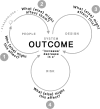Mapping outcomes in quality improvement and system design activities: the outcome identification loop and system impact model
- PMID: 31544162
- PMCID: PMC6730601
- DOI: 10.1136/bmjoq-2018-000439
Mapping outcomes in quality improvement and system design activities: the outcome identification loop and system impact model
Abstract
Background: Whether explicit or implicit, models of value are fundamental in quality improvement (QI) initiatives. They embody the desirability of the impact of interventions-with either foresight or hindsight. Increasingly impact is articulated in terms of outcomes, which are often prescribed and sometimes inappropriate. Currently, there is little methodological guidance for deriving an appropriate set of outcomes for a given QI initiative. This paper describes a structured approach for identifying and mapping outcomes.
Overall approach: Central to the approach presented here is the engagement of teams in the exploration of the system that is being designed into. This methodology has emerged from the analysis and abstraction of existing methods that define systems in terms of outcomes, stakeholders and their analogues. It is based on a sequence of questions that underpin these methods.
Outcome elicitation tools: The fundamental questions of outcome elicitation can be concatenated into a structured process, within the Outcome Identification Loop. This system-analysis process stimulates new insights that can be captured within a System Impact Model.The System Impact Model reconciles principles of intended cause/effect, with knowledge of unintended effects more typically emphasised by risk approaches. This system representation may be used to select sets of outcomes that signify the greatest impact on patients, staff and other stakeholders. It may also be used to identify potential QI interventions and to forecast their impact.
Discussion and conclusions: The Outcome Identification Loop has proven to be an effective tool for designing workshops and interviews that engage stakeholders, critically in the early stages of QI planning. By applying this process in different ways, existing knowledge is captured in System Impact Models and mobilised towards QI endeavours.
Keywords: complexity; health services research; healthcare quality improvement; patient-centred care; performance measures.
Conflict of interest statement
Competing interests: None declared.
Figures






Similar articles
-
Designing quality improvement initiatives: the action effect method, a structured approach to identifying and articulating programme theory.BMJ Qual Saf. 2014 Dec;23(12):1040-8. doi: 10.1136/bmjqs-2014-003103. Epub 2014 Oct 15. BMJ Qual Saf. 2014. PMID: 25319412
-
The Effectiveness of Integrated Care Pathways for Adults and Children in Health Care Settings: A Systematic Review.JBI Libr Syst Rev. 2009;7(3):80-129. doi: 10.11124/01938924-200907030-00001. JBI Libr Syst Rev. 2009. PMID: 27820426
-
The future of Cochrane Neonatal.Early Hum Dev. 2020 Nov;150:105191. doi: 10.1016/j.earlhumdev.2020.105191. Epub 2020 Sep 12. Early Hum Dev. 2020. PMID: 33036834
-
Health outcomes measurement and organizational readiness support quality improvement: a systematic review.BMC Health Serv Res. 2018 Dec 29;18(1):1005. doi: 10.1186/s12913-018-3828-9. BMC Health Serv Res. 2018. PMID: 30594193 Free PMC article.
-
A report card on quality improvement for children's health care.Pediatrics. 2001 Jan;107(1):143-55. doi: 10.1542/peds.107.1.143. Pediatrics. 2001. PMID: 11134448 Review.
Cited by
-
Applying a participatory systems and value approach in a transdisciplinary exercise: on assessing the impact of training and education initiatives.Health Syst (Basingstoke). 2023 Jul 11;12(4):446-460. doi: 10.1080/20476965.2023.2230632. eCollection 2023. Health Syst (Basingstoke). 2023. PMID: 38235305 Free PMC article.
References
-
- Clarkson PJ, Buckle P, Coleman R, et al. . Design for patient safety: a review of the effectiveness of design in the UK health service. J Eng Design 2004;15:123–40. 10.1080/09544820310001617711 - DOI
-
- Hinrichs S, Dickerson T, Clarkson PJ. A case study of design methods applied to researching medical device purchasing processes. Amj 2010;3:471–87. 10.4066/AMJ.2010.410 - DOI
-
- Elliott C, Deasley P. Creating systems that work: principles of engineering systems for the 21st century. Royal Academy of Engineering 2007.
-
- Clarkson PJ, Bogle D, Dean J, et al. . Engineering better care: a systems approach to health and care design and continuous improvement. Royal Academy of Engineering 2017:1–92.
LinkOut - more resources
Full Text Sources
